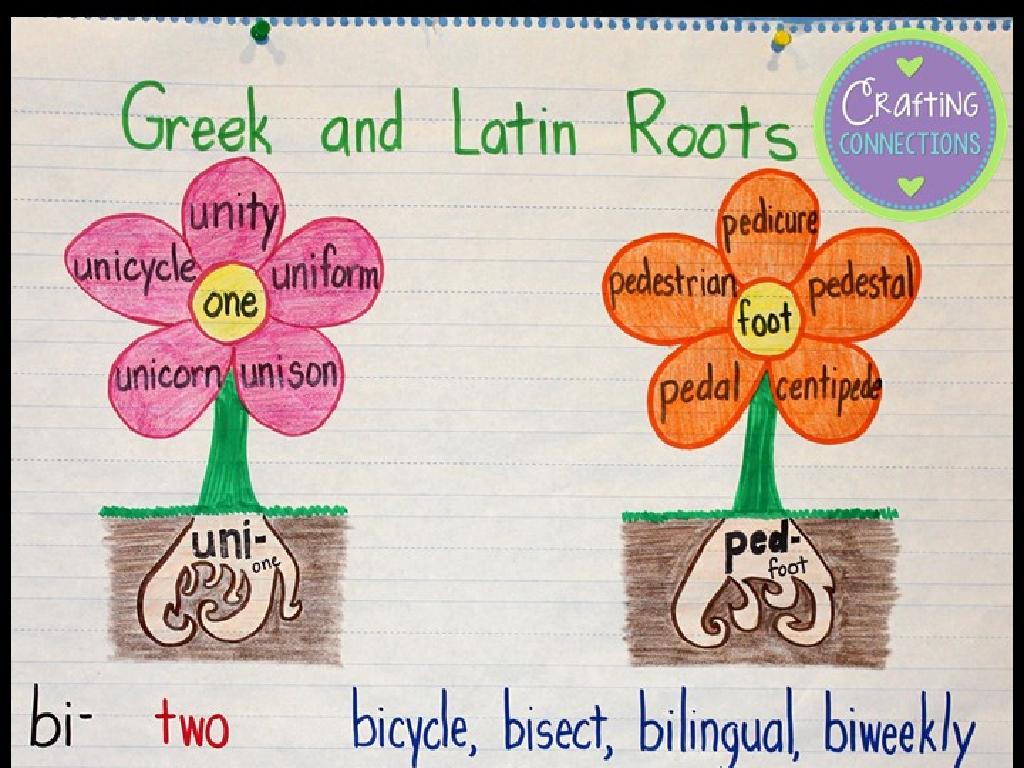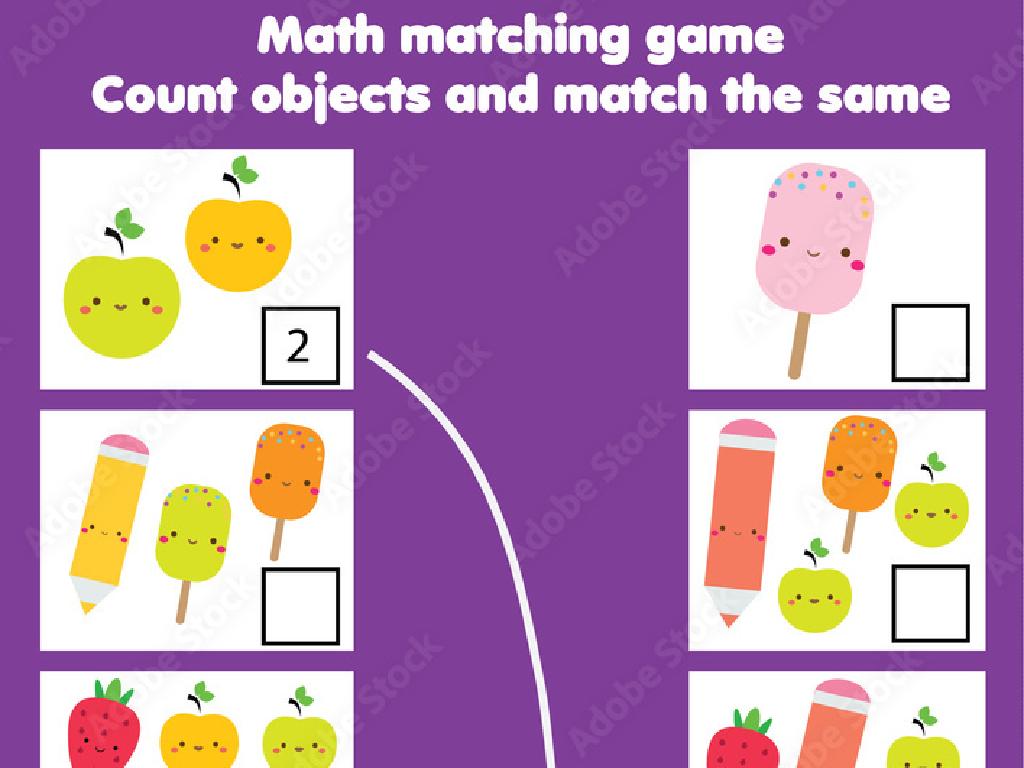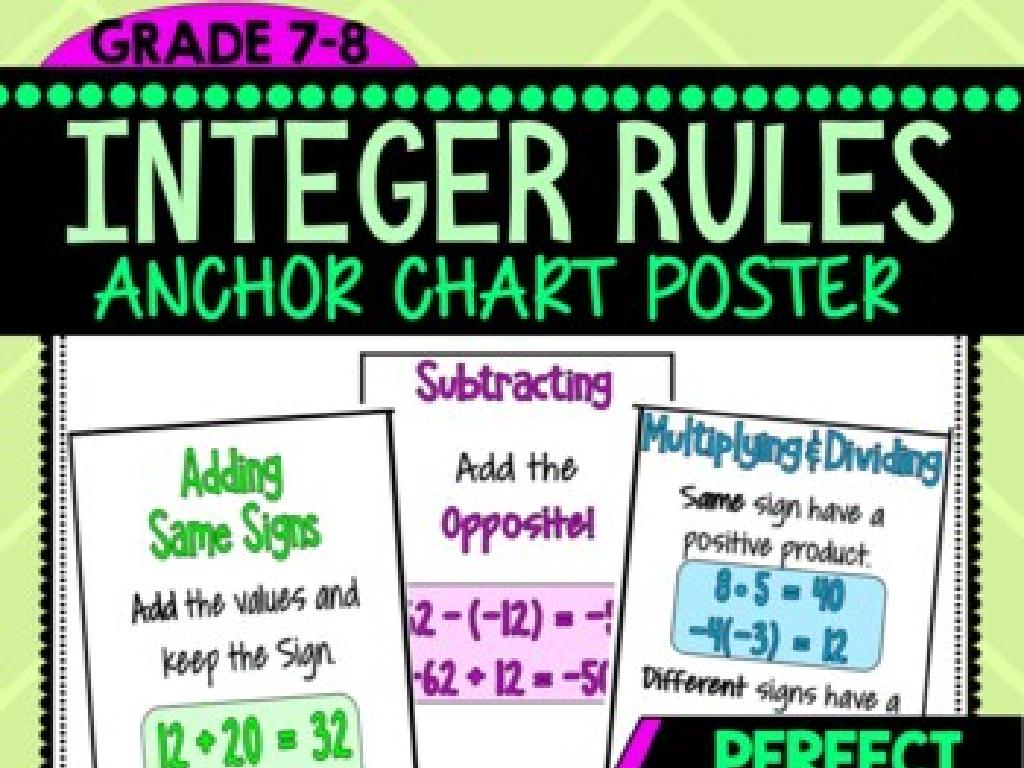Multiply And Divide Decimals By Powers Of Ten
Subject: Math
Grade: Sixth grade
Topic: Multiply And Divide Decimals
Please LOG IN to download the presentation. Access is available to registered users only.
View More Content
Multiplying and Dividing Decimals by Powers of Ten
– Recap: What are decimals?
– Decimals represent fractions of a whole, like money or measurements.
– Multiplying/dividing by powers of 10
– Moving the decimal point right (multiply) or left (divide) by the number of zeros in the power of ten.
– Real-world uses of decimal operations
– Used in finance, science, and more for precise calculations.
– Practice problems
|
Begin with a brief review of decimals to ensure students are comfortable with the concept. Explain that multiplying by powers of ten shifts the decimal point to the right, making the number larger, while dividing shifts it to the left, making the number smaller. Emphasize the practicality of these operations in everyday life, such as calculating money or distances. Conclude with practice problems to solidify their understanding, ensuring to include examples with different powers of ten. This will prepare them for more complex decimal operations in future lessons.
Multiplying Decimals by Powers of Ten
– Understanding the power of ten
– Moving the decimal point to the right for each power of ten
– Steps for multiplying decimals
– Write down the decimal, count the zeros in the power of ten, move the decimal point that many places to the right
– Example: Multiply 3.5 by 10, 100, 1000
– 3.5 x 10 = 35, 3.5 x 100 = 350, 3.5 x 1000 = 3500
– Observing the pattern
– Each time we multiply by a higher power of ten, the decimal point moves one place to the right
|
This slide introduces the concept of multiplying decimals by powers of ten. Emphasize that the power of ten refers to the number 10 raised to an exponent, which determines how many places to move the decimal point to the right. The step-by-step process involves counting the number of zeros in the power of ten and moving the decimal point in the original number accordingly. Use the example of multiplying 3.5 by 10, 100, and 1000 to show this pattern in action. Encourage students to notice how the decimal point shifts and to predict the result of multiplying by higher powers of ten. This will help them grasp the concept of place value and the base-ten number system. Provide additional examples and practice problems to reinforce the lesson.
Dividing Decimals by Powers of Ten
– Dividing by ten shifts decimal left
– Each division by 10 moves the decimal one place to the left.
– Steps to divide by 10, 100, 1000
– Place the decimal point correctly after shifting.
– Example: Divide 4.56 by 10
– 4.56 ÷ 10 = 0.456
– Continue with 100 and 1000
– Apply the same rule for 100 (0.0456) and 1000 (0.00456).
|
This slide introduces the concept of dividing decimals by powers of ten. Emphasize that when we divide by 10, the decimal point moves one place to the left, which is the same as making the number ten times smaller. For dividing by 100 or 1000, the decimal moves two or three places respectively. Use the example of 4.56 to illustrate this concept, showing the step-by-step process of dividing by 10, 100, and 1000. Encourage students to practice with additional examples and to understand the pattern of the decimal point moving. This will help them grasp the concept of place value and the relationship between division and powers of ten.
Patterns and Shortcuts: Decimals & Powers of Ten
– Recognize decimal movement patterns
– Moving the decimal point right or left
– Learn shortcut tricks for calculations
– Multiplying: move right, Dividing: move left
– Practice with different decimals
– Use sample decimals for hands-on learning
– Multiply & divide by powers of ten
– Apply shortcuts to solve problems quickly
|
This slide introduces students to the concept of recognizing patterns when multiplying and dividing decimals by powers of ten. Emphasize the pattern of moving the decimal point to the right when multiplying and to the left when dividing by powers of ten. Provide students with mnemonic tricks to remember these shortcuts. During practice, give students a variety of decimals to work with, reinforcing the concept through repetition. Encourage them to apply these shortcuts to solve problems more efficiently. The goal is for students to become comfortable with these movements and to understand the logic behind them, rather than just memorizing steps.
Common Mistakes in Decimal Calculations
– Avoid misplacing the decimal point
– Shifting the decimal the wrong way can change the value drastically.
– Remember to adjust for zeros
– Adding or removing zeros incorrectly alters the number’s place value.
– Use tips for accurate calculations
– Double-check your work; use estimation to verify results.
– Practice with examples
|
This slide aims to highlight common errors students make when multiplying and dividing decimals by powers of ten. Emphasize the importance of moving the decimal point correctly; each place value shift to the right or left can significantly change the number’s value. Remind students to account for zeros, as they can change a number’s place value and overall size. Provide tips such as double-checking calculations and using estimation to confirm that their answers are reasonable. Encourage students to practice with examples to build confidence and reduce the likelihood of these mistakes.
Class Activity: Decimal Operations Relay
– Form teams for the relay
– Set up relay stations
– Solve steps in sequence
Each member tackles a different decimal operation step.
– First team to finish wins
Accuracy matters! Verify each step before proceeding.
|
This activity is designed to encourage teamwork and reinforce the concept of multiplying and dividing decimals by powers of ten. Divide the class into small groups, each group becomes a team. Set up stations around the classroom where each station represents a step in a decimal operation problem involving powers of ten. Each team member is responsible for solving one step of the problem at their station before passing it on to the next member. The first team to correctly complete all steps and arrive at the correct answer wins. Ensure that each problem is appropriately challenging for sixth-grade students and involves both multiplication and division by powers of ten. Possible variations of the activity could include different powers of ten or combining operations in a single problem. Emphasize the importance of accuracy over speed to prevent careless mistakes.
Wrapping Up: Decimals & Powers of Ten
– Review of multiplying/dividing by powers of ten
– Homework: Decimal practice worksheet
– Complete problems on multiplying and dividing decimals by 10, 100, 1000.
– Next class: Word problems application
– We’ll use today’s lesson to tackle real-life problems.
– Keep practicing at home!
– Practice makes perfect; try extra problems for mastery.
|
As we conclude today’s lesson on multiplying and dividing decimals by powers of ten, it’s important to recap the key points. For homework, students are assigned a worksheet to reinforce their skills. This will prepare them for the next class, where they will apply what they’ve learned to solve word problems. Encourage students to practice these concepts at home to build confidence and proficiency. The worksheet should include a variety of problems, some of which replicate examples from class, and others that challenge students to think critically. Remind students that understanding these concepts is crucial for their future math success.






